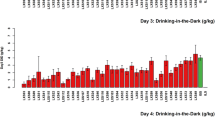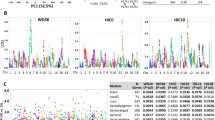Abstract
Genetic strains of mice represent an important resource for research on the biological determinants of complex diseases and behavioral phenotypes. To date, the approaches used have had little success in identifying causal genes. We have evaluated brain gene expression in C57BL/6J (B6) and DBA/2J (D2) inbred mouse strains using differential display to identify a number of sequences showing significant expression differences between the two strains. These differences were confirmed by semi-quantitative reverse transcription-polymerase chain reaction (RT-PCR) and real-time PCR. Knowing that B6 and D2 mouse strains differ for a number of behavioral phenotypes, we asked whether this difference in brain gene expression could explain any of these traits. Here, we show that the expression of two of these genes, retinaldehyde binding protein 1 (Rlbp1) and syntaxin 12 (Stx12), co-segregate with the ethanol preference phenotype in a B6D2 F2 population. Our results suggest a potential role for Rlbp1 and Stx12 in ethanol preference in mice, a conclusion supported by the location of these genes in quantitative trait loci (QTL) regions for this phenotype. This experimental approach has the potential for a broad application in the assessment of the roles of differentially expressed genes in a variety of complex phenotypes, with the advantage of identifying novel and potentially causal candidate genes directly.
Similar content being viewed by others
References
Alizadeh, M., Waada, M., Gelfman, C. M., Handa, J. T., and Hjelmeland, L. M. (2001). Downregulation of differentiation specific gene expression by oxidative stress in ARPE-19 cells. Invest. Ophthalmol. Vis. Sci. 42:2706-2713.
Bachmanov, A. A., Reed, D. R., Li, X., Li, S., Beauchamp, G. K., and Tordoff, M. G. (2002). Voluntary ethanol consumption by mice: genome-wide analysis of quantitative trait loci and their interactions in a C57BL/6ByJ × 129P3/J F2 intercross. Genome Res. 12:1257-1268.
Bachtell, R. K., Weitmier, A. Z., Galvan-Rosas, A., Tsivkovskaia, N. O., Risinger, F. O., Phillips, T. J., Grahame, N. J., and Ryabinin, A. E. (2003). The Edinger-Westphal-lateral septum urocortin pathway and its relationship to alcohol consumption. J. Neurosci. 23:2477-2487.
Belknap, J. K., Crabbe, J. C., and Young, E. R. (1993a). Voluntary consumption of ethanol in 15 inbred mouse strains. Psychopharmacology (Berl.) 112:503-510.
Belknap, J. K., Metten, P., Helms, M. L., O'Toole, L. A., Angeli-Gade, S., Crabbe, J. C., and Phillips, T. J. (1993b). Quantitative trait loci (QTL) applications to substances of abuse: physical dependence studies with nitrous oxide and ethanol in BXD mice. Behav. Genet. 23:213-222.
Browman, D. E., and Crabbe, J. C. (2000). Quantitative trait loci affecting ethanol sensitivity in BXD recombinant inbred mice. Alcohol. Clin. Exp. Res. 24:17-23.
Buck, K. J., Rademacher, B. L. S., Metten, P., and Crabbe, J. C. (2002). Mapping murine loci for physical dependence on ethanol. Psychopharmacology (Berl.) 160:398-407.
Chomczynski, P., and Sacchi, N. (1987). Single-step method of RNA isolation by acid guanidinium thiocyanate-phenol-chloroform extraction. Anal. Biochem. 162:156-159.
Cowen, M. S., Schroff, K-C., Gass, P., Sprengel, R., and Spanagel, R. (2003). Neurobehavioral effects of alcohol in AMPA receptor subunit (GluR1) deficient mice. Neuropharmacology 45:325-333.
Crabbe, J. C. (2002). Alcohol and genetics: new models. Am. J. Med. Genet. 114:969-974.
Daniels, G. M., and Buck, K. J. (2002). Expression profiling identifies strain-specific changes associated with ethanol withdrawal in mice. Genes Brain Behav. 1:35-45.
Demarest, K., McCaughran, J., Mahjubi, E., Cipp, L., and Hitzemann, R. (1999). Identification of an acute ethanol response quantitative trait locus on mouse chromosome 2. J. Neurosci. 19:549-561.
Eichers, E. R., Green, J. S., Stockton, D. W., Jackman, C., Whelan, J., McNamara, J. A., Johnson, G. J., Lupski, J. R., and Katsanis, N. (2002). Newfoundland rod-cone dystrophy, an early onset, severe retinal dystrophy caused by splice junction mutations in RLBP1. Am. J. Hum. Genet. 70:955-964.
Fernandez, J. R., Vogler, G. P., Tarantino, L. M., Vignetti, S., Plomin, R., and McClearn, G. E. (2001). Sex-exclusive quantitative trait loci influences in alcohol-related phenotypes. Am. J. Med. Gen. 88:647-652.
Gehle, V. M., and Erwin, G. (1998). Common quantitative trait loci for alcohol-related behaviors and CNS neurotensin measures: voluntary ethanol consumption. Alcohol. Clin. Exp. Res. 22:401-408.
Gerlai, R. (2002). Phenomics: fiction or future? Trends Neurosci. 25:506-509.
Grahame, N. J., Li, T-K., and Lumeng, L. (1999). Selective breeding for high and low alcohol preference in mice. Behav. Genet. 29:47-57.
Harrison, M., and Singh, S. M. (2002). Genetics and differential expression of NADH:Ubiquinone oxidoreductase B8 subunit in brains of genetic strains of mice differing in voluntary alcohol consumption (VAC). Biochim. Biophys. Acta 1579:164-172.
Heath, P. R., and Shaw, P. J. (2002). Update on the glutamatergic neurotransmitter system and the role of excitotoxicity in amyotrophic lateral sclerosis. Muscle Nerve 26:438-458.
Hirling, H., Steiner, P., Chaperon, C., Marsault, R., Regazzi, R., and Catsicas, S. (2000). Syntaxin 13 is a developmentally regulated SNARE involved in neurite outgrowth and endosomal trafficking. Eur. J. Neurosci. 12:1913-1923.
Inoue, K., and Lupski, J. R. (2003). Genetics and genomics of behavioural and psychiatric disorders. Curr. Opin. Genet. Dev. 13:303-309.
Kennedy, B. N., Li, C., Ortego, J., Coca-Prados, M., Sarthy, V. P., and Crabb, J. W. (2003). CRALBP transcriptional regulation in ciliary epithelial, retinal Müller and retinal pigment epithelial cells. Exp. Eye Res. 76:257-260.
Krystal, J. H., Petrakis, I. L., Mason, G., Trevisan, L., and D'Souza, D. C. (2003). N-methyl-D-aspartate glutamate receptors and alcoholism: reward, dependence, treatment, and vulnerability. Pharmacol. Ther. 99:79-94.
Lee, S. H., Valtschanoff, J. G., Kharazia, V. N., Weinberg, R., and Sheng, M. (2001). Biochemical and morphological characterization of an intracellular membrane compartment containing AMPA receptors. Neuropharmacology 41:680-692.
Lewohl, J. M., Wang, L., Miles, M. F., Zhang, L., Dodd, P. R., and Harris, R. A. (2000). Gene expression in human alcoholism: microarray analysis in frontal cortex. Alcohol. Clin. Exp. Res. 24:1873-1882.
Lin, N., and Hubbard, J. I. (1995). An NMDA receptor antagonist reduces ethanol preference in untrained but not trained rats. Brain Res. Bull. 36:421-424.
Loney, K., Uddin, K. R., and Singh, S. M. (2003). Strain-specific brain metallothionein (MT-II) gene expression, its ethanol responsiveness, and association with voluntary alcohol consumption (VAC) in mice. Alcohol. Clin. Exp. Res. 27:388-395.
Mayfield, R. D., Lewohl, J. M., Dodd, P. R., Herlihy, A., Liu, J., and Harris, R. A. (2002). Patterns of gene expression are altered in the frontal and motor cortices of human alcoholics. J. Neurochem. 81:802-813.
McClearn, G. E., and Rodgers, D. A. (1959). Differences in alcohol preference among inbred strains of mice. Q. J. Stud. Alcohol 20:691-695.
McVicker, B. L., and Casey, C. A. (1999). Ethanol-impaired hepatic protein trafficking: concepts from the asialoglycoprotein receptor system. Clin. Biochem. 32:557-561.
Meliska, C. J., Bartke, A., McGlacken, G., and Jensen, R. A. (1995). Ethanol, nicotine, amphetamine, and aspartame consumption and preferences in C57BL/6 and DBA/2 mice. Pharmacol. Biochem. Behav. 50:619-626.
Melo, J. A., Shendure, J., Pociask, K., and Silver, L. M. (1996). Identification of sex-specific quantitative trait loci controlling alcohol preference in C57BL/6 mice. Nat. Genet. 13:147-153.
Murphy, B. C., Chiu, T., Harrison, M., Uddin, R. K., and Singh, S. M. (2002). Examination of ethanol responsive liver and brain specific gene expression, in the mouse strains with variable ethanol preferences, using cDNA expression arrays. Biochem. Genet. 40:395-410.
Nagy, L. E., Lakshman, M. R., Casey, C. A., and Bearer, C. F. (2002). Ethanol and membrane protein trafficking: diverse mechanisms of ethanol action. Alcohol. Clin. Exp. Res. 26:287-293.
Nguyen, P. V., and Gerlai, R. (2002). Behavioural and physiological characterization of inbred mouse strains: prospects for elucidating the molecular mechanisms of mammalian learning and memory. Genes Brain Behav. 1:72-81.
Paigen, K., and Eppig, J. T. (2000). A mouse phenome project. Mamm. Genome 11:715-717.
Phillips, T. J., Crabbe, J. C., Metten, P., and Belknap, J. K. (1994). Localization of genes affecting alcohol drinking in mice. Alcohol. Clin. Exp. Res. 18:931-941.
Prekeris, R., Klumperman, J., Chen, Y. A., and Scheller, R. H. (1998). Syntaxin 13 mediates cycling of plasma membrane proteins via tubulovesicular recycling endosomes. J. Cell Biol. 143:957-971.
Rijk, H., Crabbe, J. C., and Rigter, H. (1982). A mouse model of alcoholism. Physiol. Behav. 29:833-839.
Rodriguez, L. A., Plomin, R., Blizard, D. A., Jones, B. C., and McClearn, G. E. (1994). Alcohol acceptance, preference, and sensitivity in mice. I. Quantitative trait loci mapping analysis using BXD recombinant inbred strains. Alcohol. Clin. Exp. Res. 18:1416-1422.
Rodriguez, L. A., Plomin, R., Blizard, D. A., Jones, B. C., and McClearn, G. E. (1995). Alcohol acceptance, preference, and sensitivity in mice. II. Quantitative trait loci mapping analysis using BXD recombinant inbred strains. Alcohol. Clin. Exp. Res. 19:367-373.
Saari, J. C., Nawrot, M., Kennedy, B. N., Garwin, G. G., Hurley, J. B., Huang, J., Possin, D. E., and Crabb, J. W. (2001). Visual cycle impairment in cellular retinaldehyde binding protein (CRALBP) knockout mice results in delayed dark adaptation. Neuron 29:739-48.
Saito, M., Smiley, J., Toth, R., and Vadasz, C. (2002). Microarray analysis of gene expression in rat hippocampus after chronic ethanol treatment. Neurochem. Res. 27:1221-1229.
Sandberg, R., Yasuda, R., Pankratz, D. G., Carter, T. A., Del Rio, J. A., Wodicka, L., Mayford, M., Lockhart, D. J., and Barlow, C. (2000). Regional and strain-specific gene expression mapping in the adult mouse brain. Proc. Natl. Acad. Sci. USA. 97:11038-11043.
Sarria, J-C. F., Catsicas, S., Hornung, J-P., and Hirling, H. (2002). Developmental and spatial expression pattern of syntaxin 13 in the mouse central nervous system. Cell Tissue Res. 309:309-218.
Schreiber, R., and Freund, W-D. (2000). Glutamate transport is downregulated in the cerebral cortex of alcohol-preferring rats. Med. Sci. Monit. 6:649-652.
Shelton, K. L., and Grant, K. A. (2002). Discriminative stimulus effects of ethanol in C57BL/6J and DBA/2J inbred mice. Alcohol. Clin. Exp. Res. 26:747-757.
Tabakoff, B., Bhave, S. V., and Hoffman, P. L. (2003). Selective breeding, quantitative trait locus analysis, and gene arrays identify candidate genes for complex drug-related behaviors. J. Neurosci. 23:4491-4498.
Tarantino, L. M., McClearn, G. E., Rodriguez, L. A., and Plomin, R. (1998). Confirmation of quantitative trait loci for alcohol preference in mice. Alcohol. Clin. Exp. Res. 22:1099-1105.
Tecott, L. H. (2003). The genes and brains of mice and men. Am. J. Psychiatry 160:646-656.
Thibault, C., Lai, C., Wilke, N., Duong, B., Olive, M. F., Rahman, S., Dong, H., Hodge, C. W., Lockhart, D. J., and Miles, M. F. (2000). Expression profiling of neural cells reveals specific patterns of ethanol-responsive gene expression. Mol. Pharmacol. 52:1593-1600.
Treadwell, J. A., and Singh, S. M. (2004). Microarray analysis of mouse brain gene expression following acute ethanol treatment. Neurochem. Res. 29:357-369.
Zamanillo, D., Sprengel, R., Hvalby, O., Jensen, V., Burnashev, N., Rozov, A., Kaiser, K. M., Koster, H. J., Borchardt, T., Worley, P., Lubke, J., Frotscher, M., Kelly, P. H., Sommer, B., Andersen, P., Seeburg, P. H., and Sakmann, B. (1999). Importance of AMPA receptors for hippocampal synaptic plasticity but not for spatial learning. Science 284:1805-1811.
Author information
Authors and Affiliations
Rights and permissions
About this article
Cite this article
Treadwell, J.A., Pagniello, K.B. & Singh, S.M. Genetic Segregation of Brain Gene Expression Identifies Retinaldehyde Binding Protein 1 and Syntaxin 12 as Potential Contributors to Ethanol Preference in Mice. Behav Genet 34, 425–439 (2004). https://doi.org/10.1023/B:BEGE.0000023648.78190.ee
Issue Date:
DOI: https://doi.org/10.1023/B:BEGE.0000023648.78190.ee




